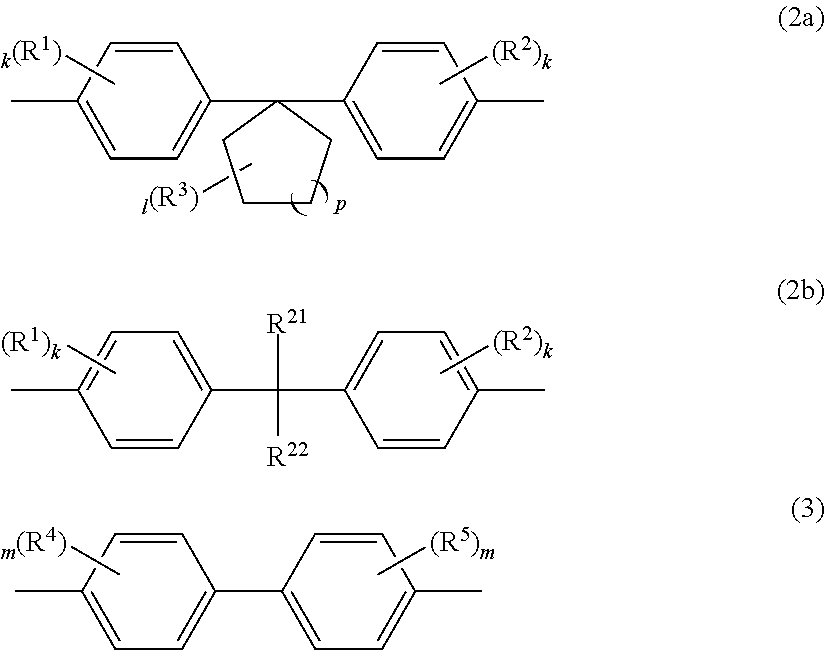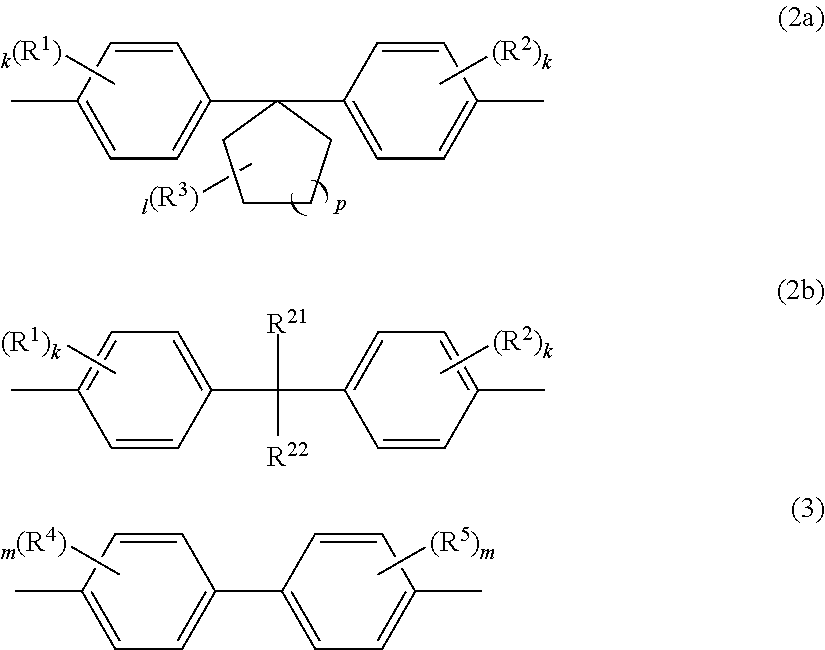Polycarbonate copolymer
a polycarbonate and copolymer technology, applied in the field of polycarbonate copolymer, can solve the problems of insufficient durability of resins, inability to meet such requests, and resins disclosed in patent documents 2 and 3 can not sufficiently prevent, etc., to achieve high viscosity, good compatibility, and adequate viscosity
- Summary
- Abstract
- Description
- Claims
- Application Information
AI Technical Summary
Benefits of technology
Problems solved by technology
Method used
Image
Examples
production example 1
Synthesis of bisphenol-Z oligomer (bischloroformate)
[0194]56.6 kg (224 mol) of 1,1-bis(4-hydroxyphenyl)cyclohexane(bisphenol-Z) was suspended in 1080 L of methylene chloride and was dissolved by adding 66.0 kg (667 mol) of phosgene to the resulting suspension. Thereto, the solution obtained by dissolving 44.0 kg (435 mol) of triethylamine in 120 L of methylene chloride was added dropwise at 2.2 to 17.8° C. for 2 hours and 50 minutes. After the resulting solution was stirred at 17.9 to 19.6° C. for 30 minutes, 900 L of methylene chloride was distilled off at 14 to 20° C. The remaining solution was cleaned by adding 210 L of pure water, 1.2 kg of concentrated hydrochloric acid and 450 g of hydrosulfite.
[0195]After that, cleaning with 210 L of pure water was repeated five times to obtain a methylene chloride solution (Z—CF) of biphenol Z oligomer having a chloroformate group at the molecular terminal.
[0196]The concentration of chloroformate in the solution obtained was 1.14 mol / L, the ...
production example 2
Synthesis of bisphenol CZ oligomer (bischloroformate)
[0200]To a mixture of 266 g (0.897 mol) of 1,1-bis(3-methyl-4-hydroxyphenyl)cyclohexane (bisphenol CZ), 1058 ml of methylene chloride and 187 g (1.89 mol) of phosgene, a solution obtained by diluting 199.4 g (1.97 mol) of triethylamine with 460 ml of methylene chloride was added dropwise at 13 to 16° C. for 3 hours and 6 minutes. The reaction mixture was stirred at 14 to 16° C. for one hour and 38 minutes. The reaction mixture was cleaned by adding 5.0 ml of concentrated hydrochloric acid and 200 ml of pure water. After that, cleaning with water was repeated until the water phase became neutral to obtain a methylene chloride solution (CZ—CF) of a bisphenol CZ oligomer having a chloroformate group at the molecular terminal.
[0201]The concentration of chloroformate in the solution obtained was 1.01 mol / L, the concentration of solid matter was 0.22 kg / L and the average number of monomers was 1.10.
production example 3
Synthesis of bisphenol FCZ oligomer (bischlorofonnate)
[0202]To a mixture of 250 g (0.595 mol) of 1,1-bis(3-trifluoromethyl-4-hydroxyphenyl)cyclohexane(bisphenol FCZ), 1020 ml of methylene chloride and 187 g (1.89 mol) of phosgene, a solution obtained by diluting 199.4 g (1.97 mol) of triethylamine with 460 ml of methylene chloride was added dropwise at 13 to 16° C. for 3 hours and 6 minutes. The reaction mixture was stirred at 14 to 16° C. for one hour and 38 minutes. The reaction mixture was cleaned by adding 5.0 ml of concentrated hydrochloric acid and 200 ml of pure water. After that, cleaning with water was repeated until the water phase became neutral to obtain a methylene chloride solution (FCZ—CF) of a bisphenol FCZ oligomer having a chloroformate group at the molecular terminal.
[0203]The concentration of chloroformate in the solution obtained was 1.04 mol / L, the concentration of solid matter was 0.23 kg / L and the average number of monomers was 1.05.
PUM
| Property | Measurement | Unit |
|---|---|---|
| temperature | aaaaa | aaaaa |
| concentration | aaaaa | aaaaa |
| molar ratio | aaaaa | aaaaa |
Abstract
Description
Claims
Application Information
 Login to View More
Login to View More - R&D
- Intellectual Property
- Life Sciences
- Materials
- Tech Scout
- Unparalleled Data Quality
- Higher Quality Content
- 60% Fewer Hallucinations
Browse by: Latest US Patents, China's latest patents, Technical Efficacy Thesaurus, Application Domain, Technology Topic, Popular Technical Reports.
© 2025 PatSnap. All rights reserved.Legal|Privacy policy|Modern Slavery Act Transparency Statement|Sitemap|About US| Contact US: help@patsnap.com



